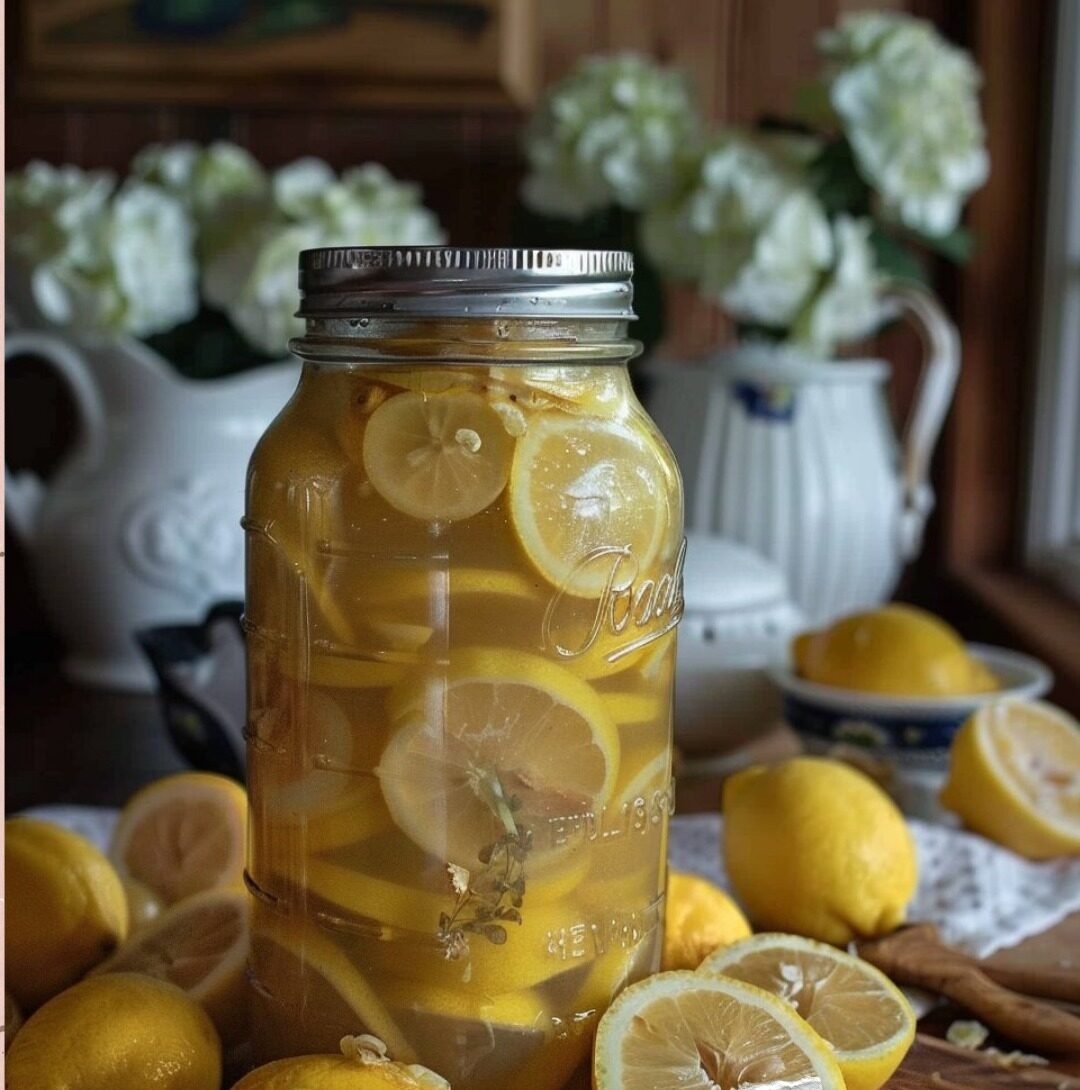
Fermented Lemons: Dive into a World of Bright, Tangy Flavor!
Hey there, Jason Griffith here! If you’re looking to add a truly unique, bright, and deeply flavorful twist to your culinary repertoire, then venturing into the world of fermentation is a fantastic step. These Fermented Lemons are an absolute revelation – transforming simple citrus into a complex, tangy, and subtly salty condiment that brings an incredible depth of flavor to almost any dish. Get ready to discover a delightful ingredient that will liven up your cooking in surprising ways!
Why I Love This Recipe
I’m incredibly passionate about exploring traditional food preservation methods that unlock new dimensions of flavor, and fermenting lemons is a perfect example. What I particularly love about this recipe is its transformative power. The fermentation process mellows the lemons’ sharp acidity, deepens their citrus notes, and infuses them with a wonderful umami tang. They become incredibly versatile, adding a concentrated burst of bright, salty, and subtly sweet flavor. It’s a simple, hands-off process that yields a gourmet-level ingredient perfect for elevating everything from roasted vegetables to tagines. Plus, it’s a fantastic way to preserve a bounty of lemons!
Ingredients
Here’s what you’ll need to create your own vibrant batch of fermented lemons:
- 10 lemons (medium-sized, organic or unwaxed preferred)
- Kosher salt (or other non-iodized salt, like sea salt)
- 1 tablespoon of salt (for the bottom of the jar)
Swaps and Notes
- Lemons: Use firm, fresh, organic, or unwaxed lemons if possible, especially since you’ll be using the rind. Regular lemons should be scrubbed thoroughly to remove any wax coating. You can use Meyer lemons for a sweeter, less acidic fermented lemon.
- Salt: Kosher salt or non-iodized sea salt is crucial for fermentation. Iodine in table salt can inhibit beneficial bacteria and lead to off-flavors.
- Jar: Use a clean, sterilized glass jar (a quart-sized mason jar works well) with a tight-fitting lid. Sterilize by boiling for 10 minutes or running through a hot dishwasher cycle.
- Fermenting Weight (Optional but Recommended): A fermenting weight (a glass disc designed to keep ferments submerged) is ideal. If you don’t have one, a clean, small glass jar or a zip-top bag filled with brine can act as a makeshift weight. Keeping the lemons submerged is vital to prevent mold.
- Burping the Jar: Releasing gases is important, especially in the first week or two of fermentation, to prevent pressure buildup.
- Patience: Fermentation takes time! Don’t rush the 4-week process for best flavor development.
Directions
Fermenting lemons is a surprisingly simple process that requires patience and a watchful eye!
- Prepare Lemons: Start by washing your lemons thoroughly. Then, chop off just the tops and bottoms, being careful not to cut too much away from the main body of the lemon.
- Score Lemons: Stand each lemon upright on one of the cut ends. Using a sharp knife, score an “X” into the skin of each one, cutting about two-thirds of the way down towards the opposite end, but not all the way through. This creates pockets for the salt.
- Salt the Lemons: Pack about 1 teaspoon of Kosher salt into each scored lemon, really getting it into those cuts and spreading it over the cut surfaces.
- Salt the Jar: In a clean, sterilized jar (a quart-sized mason jar is ideal), sprinkle 1 tablespoon of Kosher salt at the bottom.
- Fill Jar with Lemons: Now, carefully fill that jar with the salted lemons. Press down firmly as you go to release their juices and pack them tightly.
- Add Remaining Juice: Take any remaining lemons (or even the scraps from trimming, if you have space) and roll them on your countertop with the palm of your hand to release more juice. Add that juice to the jar until the lemons are completely covered. It’s crucial that all the lemon pieces stay submerged in their brine.
- Add Fermenting Weight (or Improvise): If you have a fermenting weight, pop that on top of the lemons to keep them submerged. If not, you can improvise with half a lemon (that you didn’t salt) placed on top, or a small, clean glass filled with a few pebbles to weigh it down, ensuring it stays under the liquid.
- Seal & Ferment: Secure the lid tightly on the jar. Let your lemons ferment at room temperature (ideally between 65-75°F / 18-24°C) for about 4 weeks. This is where the magic happens!
- Flip & “Burp”: Remember to flip the jar upside down every couple of days (especially during the first week or two) to redistribute the salt and juice. Also, give it a little “burp” every now and then (by loosening the lid briefly to release built-up gases) to prevent pressure buildup.
- Storage: Once fermented (they will soften and develop a complex, tangy aroma), your lemons can last for 6-12 months as long as they stay submerged in their brine in the refrigerator. After the initial 4 weeks of fermentation, transfer the jar to the refrigerator. Enjoy the vibrant flavors!
Tips for Success
- Cleanliness is Key: While fermentation is about beneficial bacteria, starting with a very clean, sterilized jar is important to avoid unwanted mold or spoilage.
- Submerged is Vital: Always keep the lemons fully submerged in their brine. Any pieces exposed to air are prone to mold. Use a weight if necessary.
- Don’t Fear the “Fizzy”: It’s normal for the lemons to bubble and produce gas; this is a sign of healthy fermentation.
- Patience: The longer they ferment (up to 4 weeks at room temp), the more complex and mellow their flavor will become.
- Taste Test: After 4 weeks, taste a small piece. It should be pleasantly salty, tangy, and mellow, not overly bitter or harsh.
Serving Suggestions and Pairings
Fermented lemons (often referred to as preserved lemons once fully cured) are an incredibly versatile and powerful ingredient. A little goes a long way!
- Mediterranean & Middle Eastern Cuisine: Classic in tagines, couscous, roasted chicken, and fish dishes.
- Salads: Mince a small piece (rind and pulp) and add to grain salads, green salads (like my A Light, Tangy Chicken Salad I Actually Crave (and There’s No Mayo in Sight!)), or dressings for a bright, salty kick.
- Roast Vegetables: Toss with roasted potatoes, asparagus, or cauliflower after cooking.
- Seafood: Pair with grilled fish or shrimp.
- Dips: Finely chop and stir into hummus, yogurt dips, or even a creamy cheese spread.
- Pasta: Mince and add to simple olive oil-based pasta dishes.
- Drinks: A tiny slice in sparkling water or a cocktail (like a gin and tonic) for a unique twist.
Storage and Leftover Tips
Once fermented, transfer the sealed jar to the refrigerator. The cold temperature will slow down the fermentation process significantly. They will last for 6-12 months in the fridge, as long as they remain submerged in their brine. Always ensure the lemons are covered by liquid; if not, add a little extra lemon juice or a weak brine (1 tsp salt per 1 cup water). Use clean utensils to remove pieces from the jar.
More Recipes You Will Love
If you loved the unique flavor and the satisfaction of making your own condiments, here are a few more fantastic recipes that I think you’ll absolutely love:
- For another tangy homemade condiment with a kick, try my Zesty Jalapeno Relish.
- If you’re a fan of fresh, vibrant flavors, my This Blueberry Lemonade Is My Favorite Refreshing Drink for Sunny Days is perfect.
- For a sweet-tart spread, my Homemade Peach Jam is a delightful way to preserve fruit.
- And for other interesting savory sides, check out my Mushroom Marsala Baked Brie.
Final Thoughts
Fermenting lemons is an incredibly rewarding culinary adventure that brings an unparalleled depth of tangy, bright flavor to your kitchen. It’s a simple process with gourmet results, proving that some of the best flavors are born from patience. Dive in, and enjoy the vibrant world of fermented lemons!
What’s your favorite way to incorporate unique or fermented flavors into your cooking? Share your ideas and feedback in the comments below, and don’t forget to follow Chef Maniac for more delightful and inspiring recipes!




Leave a Reply